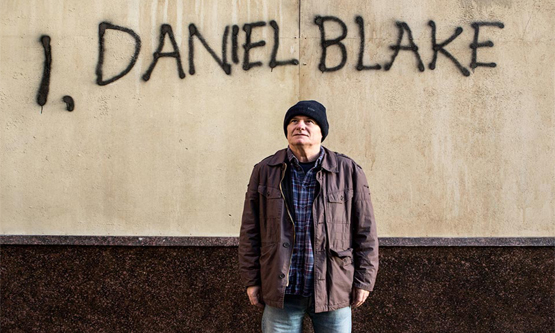
Ken Loach’s new film, I, Daniel Blake, paints an intimate picture of the brutality of Britain’s sanction-driven benefits system. The plot hinges upon the human consequences of Employment and Support Allowance (ESA) ‘fit for work’ judgements, and Jobseeker’s sanctions. By focusing upon a small cast of characters, Loach succeeds in portraying the sheer barbarity of poverty in Britain. I, Daniel Blake is a powerful argument for human dignity; depicting Newcastle’s jobcentres, food banks and run-down industrial estates as theatres of cruelty.
Between January and June 2016, a total of 165,013 Jobseeker’s Allowance (JSA) claimants were referred for a sanction. 81,195 (49.2%) of these referrals resulted in sanctions. Over the same period 7,034 ESA claimants were sanctioned and deprived of their income. An October 2016 study published by Oxford University – ‘The impact of benefit sanctioning on food insecurity’ – clearly demonstrates the relationship between benefit sanctions and the use of food banks. It demonstrates that after the application of one million benefit sanctions in 2013, reliance upon food banks tripled. Trussell Trust statistics reveal that 21% of all referrals to their food banks are due to benefit sanctions.
It is to this reality that Loach turns his camera. He returns to the tradition of social realism, echoing his earlier work in Cathy Come Home (1966). The film paces its incidents as if constructing an argument, yet remains convincing throughout. Worthy of particular credit are the depiction of Daniel Blake’s ESA sanction at the film’s opening and the consistent characterisation of jobcentre advisors. In both instances the DWP bureaucracy functions both irrationally and sadistically. The criteria applied to Daniel are incapable of accurately assessing his health problems and his objections to this are met by thinly veiled threats. The film’s leading support character, Katie, is a single mother with two children. After being forced out of East London and moving to Newcastle, she is sanctioned for being ten minutes late to her JSA appointment. The advisor has her removed from the jobcentre by security for daring to complain that she doesn’t know her way around the city yet. This brutal and vindictive logic directs the whole film’s plot, with both Daniel and Katie completely at the mercy of a dehumanising system of economic violence.
Katie’s plot serves as an example of the breadth of content that Loach is trying to cover. It touches upon the insecure housing conditions facing the working class, hunger and women’s oppression. When she starves herself in order to feed and clothe her children, Loach highlights the enormous increase in malnutrition that has accompanied austerity. In the ten years since 2006 hospital admittances for malnutrition have quadrupled. This starvation leads her to humiliation at a food bank, to shoplifting and to finding employment as a sex worker. If anything, the film is too optimistic here. Research from February 2016 revealed that sex workers in Newcastle were offering their service for as little as £2 in a desperate bid to survive.
The reality that I, Daniel Blake depicts is both its strongest point and its weakest. The film succeeds in showing the brutality of the benefits system and the conditions that face the poorest sections of the working class. However, owing to Loach’s insistence in keeping the work one of social realism, its message ends here. As there are no politically conscious characters in I, Daniel Blake, Loach offers us no indication of how to resolve the questions the film raises. The only action of resistance that Daniel takes is to graffiti the side of the jobcentre with his demand for an appeal against his ESA decision. After dodging the question of how the police usually react to criminal damage, Loach ends the film by having Daniel die of a heart attack at his appeal. Loach creates the image of a malevolent state, its murderous will expressed by the benefit decision makers who hold in their hands power over life and death. In the face of such a monster he does not instruct us to fight. As Katie reads Daniel’s appeal out at his funeral, his speech insisting that he be treated with dignity as a human being, it becomes clear that Loach is pleading for reform.
This becomes even more telling when we consider how the film has been used following its release. Under the hashtag ‘#WeAreAllDanielBlake’ the I, Daniel Blake Facebook and Twitter pages released a video of popular figures among the Labour left, including Labour leader Jeremy Corbyn, reading Daniel’s appeal letter. Corbyn used the film to attack Theresa May in Prime Minister’s Questions on 2 November. In the same session Scottish National Party MP Mhairi Black told Tory MPs to go and see the film as it depicts ‘the brutal and sobering reality of what life is like for those struggling most in today’s society.’ Work and Pensions Secretary Damian Green said that he hadn’t seen the film but that it ‘bears no relationship to the modern benefits system’, as it is a work of fiction. He went on to say that the film is ‘monstrously unfair to jobcentre staff’. In an interview with The Huffington Post on 5 November, Loach vouched his support for Corbyn in connection with the film, stating that he believes only Corbyn would see an end to benefit sanctions.
The British Marxist Christopher Caudwell wrote that ‘what is of importance to art, Marxism and society is the question: What social function is art playing?’ It is in this light that we must assess I, Daniel Blake. Whilst the film should be welcomed for raising the questions that it does, its use as a piece of propaganda for Corbyn and the Labour Party cannot be ignored. Despite being set in Newcastle, a Labour council which has made savage cuts (see p5) and ruthlessly implemented the Bedroom Tax, the role of the Labour councils is never addressed. We are not all Daniel Blake.
James Bell
Fight Racism! Fight Imperialism! 254 December 2016/January 2017




